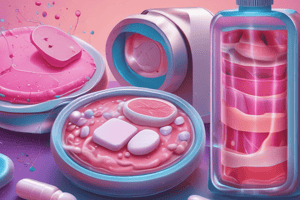Podcast
Questions and Answers
What is transappendageal transport primarily involved with?
What is transappendageal transport primarily involved with?
- Drug transport through the bloodstream
- Drug transport through the dermis layer
- Drug transport through the epidermis layer
- Drug transport through the skin appendages (correct)
Which of the following is NOT a type of skin appendage involved in transappendageal transport?
Which of the following is NOT a type of skin appendage involved in transappendageal transport?
- Muscle fibers (correct)
- Sweet glands
- Sebaceous glands
- Hair follicles
What is the primary advantage of transappendageal transport?
What is the primary advantage of transappendageal transport?
- It is a complex process
- It is a rare route
- It is a slow pathway
- It is an easy and fast pathway (correct)
Why is the sweet gland route not influential to drug transport?
Why is the sweet gland route not influential to drug transport?
What is the primary disadvantage of transappendageal transport?
What is the primary disadvantage of transappendageal transport?
Which of the following is NOT a step in the transappendageal transport process through sweet glands?
Which of the following is NOT a step in the transappendageal transport process through sweet glands?
What is the primary reason why transappendageal transport is not a significant contributor to drug transport?
What is the primary reason why transappendageal transport is not a significant contributor to drug transport?
Which of the following skin layers is NOT involved in transappendageal transport?
Which of the following skin layers is NOT involved in transappendageal transport?
What is the primary advantage of transappendageal transport in terms of the stratum corneum?
What is the primary advantage of transappendageal transport in terms of the stratum corneum?
Which of the following is a characteristic of transappendageal transport through hair follicles and sebaceous glands?
Which of the following is a characteristic of transappendageal transport through hair follicles and sebaceous glands?
What is the relationship between transappendageal transport and the dermis layer?
What is the relationship between transappendageal transport and the dermis layer?
Study Notes
Skin Permeation Pathways
- Lipoid nature of drugs allows them to pass easily through sweet glands, hair follicles, and sebaceous glands
- Targeted effect is needed for shunt transport through hair follicle and sebaceous glands routes
- Skin permeation pathways refer to the routes of drug permeation through the skin
Transport Through Stratum Corneum
- Most abundant route of drug transport through the skin
- Two main routes:
- Intercellular route: drug moves between corneocytes till it reaches viable epidermis
- Transcellular route: drug moves through corneocytes till it reaches viable epidermis
Intercellular Route
- Intercellular medium is lipid in nature, composed of phospholipids, ceramide, and cholesterol
- Suitable for small molecules with a molecular weight of less than 400 dalton
- Permeation coefficient (P) expresses the rate of drug permeation through the membrane
Transappendageal Transport (Shunt Route)
- Drug transport through skin appendages (sweet glands, hair follicles, and sebaceous glands)
- Easy and fast pathway, but less common
- Advantage: no barrier effect of stratum corneum, but disadvantage: rare route with insignificant contribution to drug transport
Transport Through Sweet Glands and Hair Follicles
- Transport through sweet glands:
- Drug molecules enter sweet openings
- Travel through sweet ducts
- Reach sweet glands
- Absorbed by blood capillaries surrounding sweet glands
- Transport through hair follicles and sebaceous glands:
- Drug molecules enter hair openings
- Travel through sebaceous sacs
- Reach sebaceous glands
- Absorbed by blood capillaries surrounding sebaceous glands
Studying That Suits You
Use AI to generate personalized quizzes and flashcards to suit your learning preferences.
Description
This quiz covers the lipoid nature of certain drugs and their ability to pass through skin permeation pathways, including sweet glands and hair follicles.




